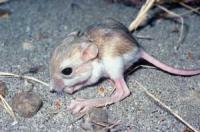
A twenty-seven day old desert kangaroo rat, Dipdomys deserti, learning how to use its cheek pouches.The warm deserts of North America are hopping with multiple species of kangaroo rats and pocket mice despite limited seed resources. Why doesn't one species win out in the rat race? Ecologist Mary Price (University of California, Riverside and University of Arizona) and theoretical biologist John Mittler (University of Washington) teamed up to explore their hunch that coexistence might follow from the propensity of these rodents to store harvested seeds and to steal from one another's caches.
"I gave up on traditional explanations when we couldn't find size-related tradeoffs in foraging rates or predator avoidance under different environmental conditions" says Price, who has spent more than twenty years exploring niche-partitioning explanations for the remarkable diversity of desert rodent communities. "I always had a suspicion that caching was important because heteromyids are so obsessive about it."
Using resource-processing models of coexistence where feeding by one species creates a modified resource another can use, the researchers found that thievery actually promotes stable coexistence if one species excels at harvesting while to other excels at stealing.
"We can't conserve biodiversity if we don't understand the processes that maintain it," Price says. "There are far more ecological interactions to understand than there are ecologists, but fortunately, we can often extrapolate from one system to others."
Price and Mittler expect that their insight into the "cache economy" of desert rodents will extend to many other systems and will suggest new ways to preserve species diversity.
Source : University of Chicago Press Journals
 Print Article
Print Article Mail to a Friend
Mail to a Friend
